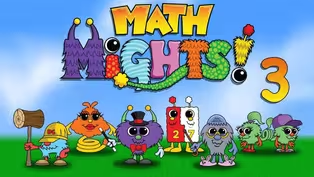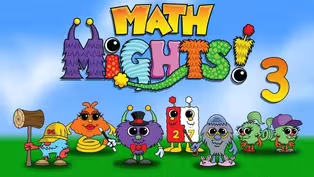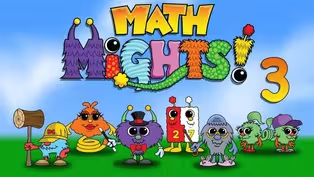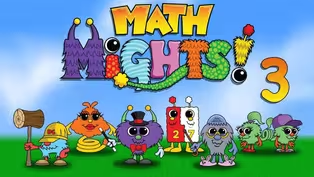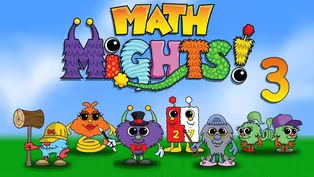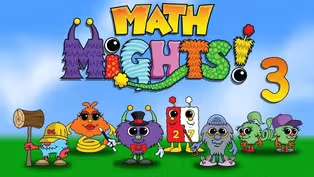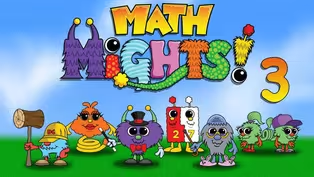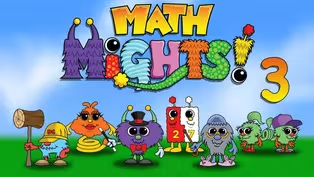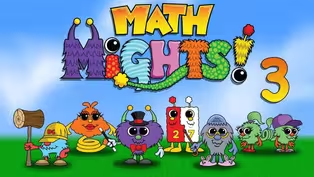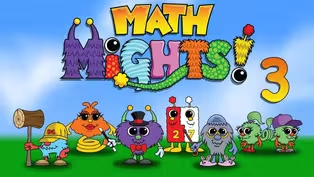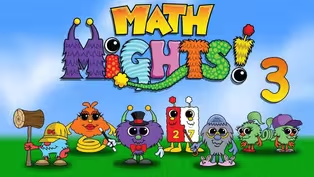Math Mights
Non-Unit Fractions
Season 3 Episode 309 | 15m 59sVideo has Closed Captions
Join Ms. Askew for a tricky multi-step word problem with Professor Barble!
Join Ms. Askew for a tricky multi-step word problem with Professor Barble! Next we are going to explore non-unit fractions by looking at shaded parts, size of each part and finding the fraction represented in shaded parts!
Problems playing video? | Closed Captioning Feedback
Problems playing video? | Closed Captioning Feedback
Math Mights is a local public television program presented by Detroit PBS
Math Mights
Non-Unit Fractions
Season 3 Episode 309 | 15m 59sVideo has Closed Captions
Join Ms. Askew for a tricky multi-step word problem with Professor Barble! Next we are going to explore non-unit fractions by looking at shaded parts, size of each part and finding the fraction represented in shaded parts!
Problems playing video? | Closed Captioning Feedback
How to Watch Math Mights
Math Mights is available to stream on pbs.org and the free PBS App, available on iPhone, Apple TV, Android TV, Android smartphones, Amazon Fire TV, Amazon Fire Tablet, Roku, Samsung Smart TV, and Vizio.
Providing Support for PBS.org
Learn Moreabout PBS online sponsorshipMore from This Collection
Build Fraction from Unit Fractions
Video has Closed Captions
Join Ms. Askew for another multi-step word problem with Professor Barble! (15m 59s)
Video has Closed Captions
Join Ms. Askew for a division word problem with her friend Professor Barble. (15m 59s)
Video has Closed Captions
Join Ms. Askew for a division word problem with her friend Professor Barble. (16m)
Video has Closed Captions
Join Ms. Askew and Professor Barble to do a visual model with a word problem. (15m 59s)
Dividing with even larger numbers
Video has Closed Captions
Join Ms. Askew and Professor Barble to do a visual model with multiplication. (15m 59s)
Video has Closed Captions
Join Ms. Askew and Professor Barble to see if you can match visual models to word problems (15m 59s)
Dividing with Larger Quotients
Video has Closed Captions
Join Ms. Askew and Professor Barble to see if you can match visual models to word problems (15m 59s)
Video has Closed Captions
Learn about multiplying one-digit whole numbers by multiples of 10. (15m 59s)
Video has Closed Captions
Learn about multiplying numbers larger than 20. (16m)
Video has Closed Captions
Join Mrs. Askew for a Number Talk with 2 Math Might Friends! (16m)
Multiply Teen Numbers with Larger Groups
Video has Closed Captions
Join Mrs. Askew for a Number talk with 2 Math Might Friends! (15m 59s)
Relating Multiplication and Division
Video has Closed Captions
Join Ms. Askew for a subtraction number talk with Springling! (16m)
Providing Support for PBS.org
Learn Moreabout PBS online sponsorship(upbeat music) - [Children] Math mights!
- Welcome, third grade math mights.
My name is Ms. Askew, and I'm so happy to see that you joined us today.
Are you ready to have some fun with math?
I sure am.
So let's check out our plan for today.
First, we're gonna do a word problem with our friend, Professor Barble.
After our word problem, we're gonna work on nine unit fractions.
Before we begin, let's warm up our brains with Professor Barble as we conquer word problems using visual models.
Now, you might be asking yourself, what is a visual model?
Well, a visual model is sometimes known as a model drawing, unit bar, tape diagram, or bar model.
A visual model is a reading comprehension strategy for word problems.
Drawing a visual model helps to visualize the strategies and understand what the word problem is asking.
I think we're gonna need Professor Barble's help to solve our problem for today.
(upbeat music) Professor Barble is a Math Might friend who likes to take hikes all throughout Mathville solving word problems.
On his hikes he's discovered that sometimes we like to rush into solving problems without even thinking.
He wants us to slow down and follow a step-by-step process to help us think about what the question is asking.
As Professor Barble solves those problems, he puts on his thinking cap and he creates a visual model to help us better understand the word problem.
Let's see what our word problem is for today.
There are 12 tables in the cafeteria.
Five students sit at each of the first 11 tables.
Three sit at the last table.
How many students are sitting at the 12 tables in the cafeteria?
Now, Destiny thinks that we should multiply to solve the problem, but Levi thinks, well, maybe we should add.
If Professor Barble heard us talking, he would say, "Wait a minute, you're already at step six.
"You're trying to solve the problem."
We need to slow down and follow a step-by-step process that will help us think about what the question is asking us.
In the first step, we're going to read the problem and put it into chunks.
As we chunk it, we're going to make sure we are identifying the important parts of the story.
There are 12 tables in the cafeteria.
That's important information to know.
So we're gonna chunk that.
Five students sit at each of the first 11 tables.
That's another good piece of information.
Three sit at the last table.
Chunk that too, because that's really important.
Now the question is, how many students are sitting at the 12 tables in the cafeteria?
In step two, we're going to rewrite the question in sentence form with a blank space for the answer.
There are blank students at the 12 tables.
It's time for you to help us out, Professor Barble.
We see that starting line coming out of your thinking cap, and that's gonna help us create a visual model.
Step three is to determine the who and what that's in the problem.
Well, we know the who are the students and the what are the tables.
We're gonna create a unit bar for step four.
I've already created mine, and it has students and the bar represents the tables.
Now, third grade math mights, we're gonna move on to step five.
Now, step five can be a little difficult, so we're gonna go through it very slowly.
Go back to the chunks and check when each part is added into the adjusted unit bars and put a question mark.
There are 12 tables in the cafeteria.
Let's label that on our unit bar, 12 tables.
Now we're gonna go back into the story problem and check it.
Five students sit at each of the first 11 tables.
Now, 11 tables is a lot to place on our unit bar, so we're gonna start with the first table.
And these dots here represent all of the tables that are in between, and we're gonna stop at 11.
And we know that five people are at the first 11 tables.
So we're gonna start five here and stop with five here.
Now let's go back and check that information in our story problem.
Three sit at the last table.
We wanna put that last table here on our unit bar.
And we know that three students sit there, so this makes our total of 12 tables.
Let's go back and check that information in our story problem.
Our question is, how many students are sitting at the 12 tables in the cafeteria?
That's what we're trying to figure out.
We don't know it yet, so we're gonna put a question mark there.
Now let's go back and check that in our story problem.
Now we're going to move on to step six where we correctly compute and solve the problem.
Looking at the visual model, Levi says, "Now I see what the problem is asking."
We need to multiply.
When looking at this, I think we have to do more than one thing in order to get the correct answer to solve this problem.
Now we have to start with the first step, and we can see how useful Professor Barble's step-by-step process is.
We know that there are 11 tables and there are five people sitting at the first 11 tables.
So 11 groups of five equals 55.
Now, if you go back and you look at the story problem, we know that there are three students sitting at that last table.
Now we're going to move on to the second step.
We know that 55 students are sitting at the first 11 tables, but then three additional students sit at the 12th table.
So we have to add those three additional students in order to figure out how many students are at the 12 tables, 55 plus three equals 58.
That takes us to our last step, step seven.
We need to write the answer in the sentence and make sure the answer makes sense.
If we have 11 times five equals 55, and we take the 55 and add an additional three, that equals 58.
So there are 58 students at the 12 tables.
Wow, third grade math mights, that word problem was really difficult.
You had to multiply in the first step, and then you had to add in the second step.
Do you see now how useful Professor Barble's step-by-step process is for solving those word problems?
I sure did.
And that visual model really hit home and made me see it a whole lot better.
Now let's move on to our I can statement for today.
I can understand non-unit fractions.
Look at the four pictures.
What do you notice?
What do you wonder?
Looking at those four pictures, I wonder, what do each of those fractions equal?
Let's see what Destiny and Levi notice.
Destiny notices that each image shows more pieces shaded.
If we look here, we can see that in the first image one part is shaded, then two parts, then three parts and four parts.
Levi notices the first one shows one fourth and the second one is one half.
We look at it, the first one is one fourth, because one out of the four parts has been shaded.
And he says the second one is one half, but hm.
Do you notice something?
Why would Levi say that that is one half?
Oh, I think I know, because half of it is not shaded and half of it is shaded.
That makes sense.
Great thinking, Levi, those were some really great notices.
Do you wonder anything by looking at those four images?
Destiny wonders, does the three stand for the number of shaded parts?
Looking at this image, we remember from the last time that the four represents the total number of parts.
Remember that word?
It's called the denominator.
And if we count the parts, we have four equal parts.
The top number is the numerator, and that represents how many parts are shaded.
And if we look at the image, one, two, three parts have been shaded.
Levi wonders, "Why are we shading one more piece each time?"
In the first image we see that one out of the four parts has been shaded, and that fraction is called one fourth.
In the second image, we see that two out of the four parts have been shaded, and that fraction is two fourths.
In the third image, we see three out of the four parts has been shaded, and that fraction is three fourths.
And in the final image, we see that four parts out of the total four have been shaded, and that fraction is called four fourths.
Great job on that first activity.
Now let's work through figuring out nine unit fractions.
We have an activity that's gonna help us figure out those fractions.
Let's take a look at this chart and look at these four images.
We wanna figure out what is missing.
And we're gonna answer the questions that are in each of these columns.
The first piece of information that we want to figure out is the number of shaded parts.
Then we're going to figure out the size of each part.
And finally, the number that represents the total amount shaded.
The first image has been done for us as an example.
The number of shaded parts is one, because one out of the four parts has been shaded.
The size of each part is one fourth because the square has been partitioned into four equal parts.
And the fraction that represents the total amount shaded is one fourth, one out of the four parts has been shaded.
Let's take a look at the second image.
We wanna figure out the number of parts shaded, one, two, three, three parts have been shaded.
Now we want to figure out the size of each part.
Again, the square has been partitioned into four equal parts, so the size of each part is one fourth.
The number that represents the total amount shaded is three fourths because three out of the four parts have been shaded.
Let's take a look at the third image.
The number of parts that have been shaded is four.
The size of each part is still one fourth because the square has been partitioned into four equal parts.
The number that represents the total amount shaded is four fourths because four parts out of the total four have been shaded.
The final image, we're going to figure out how many parts have been shaded.
One, two.
Now the size of each part changes because it has been partitioned into three equal parts.
So each part, the size is one third.
The number that represents the total amount shaded is two thirds, because two out of the three parts have been shaded.
Great job, third grade math mights, are you having as much fun as I am?
You worked really hard matching the images with the fractions.
Now let's take what you've learned and play a game called fraction match up.
In this game, you're gonna have a pile of fractions, and in another pile you're gonna have some images.
What you need to do is match the fraction with the image.
Let's try some.
Here is my pile of fractions, and these are my images.
So I'm gonna flip it over.
It's like a memory game almost.
So the first fraction is five-sixths.
I wanna find an image that has five out of six shaded.
Mm let's see, I'm gonna pick this one.
Don't think this is a match because this has been partitioned into eighths, so it can't be five-sixths.
So we'll turn those back over.
Let's try one fourth.
So I'm looking for an image that has one out of four parts shaded.
I made a match, I see that this rectangle has been partitioned into four parts, and one part is shaded.
So that's one fourth.
Let's try another one.
How about three-eighths?
So that means I'm looking for an image that has eight parts with three of the parts shaded.
Lucky me, I've found another match.
This has been partitioned into eight parts, and three out of those eight parts have been shaded.
I have another match.
Does this seem like a game that you would wanna play, third grade math mights?
It sure makes fractions a lot more fun to me.
All right, third grade math mights, let's try one more turn.
The fraction is three-fourths, which means I have to look for an image that has three out of the four parts shaded.
Which one should it be?
I think I have a match.
This square has been partitioned into four equal parts, and three of those parts have been shaded, I have a match.
I had so much fun playing that game, third grade math might friends.
Now it's your turn to play with a friend.
Thanks for joining us, third grade math mights, we had so much fun learning about word problems with professor Barble, and we even had fun with fractions, doing that fraction matchup game.
I hope you join us next time when we do more with fractions, have a great day.
(upbeat music) - [Narrator] Sis4teachers.org.
Changing the way you think about math.
- [Narrator] This program is made possible with funding from the Michigan Department of Education, Governor's Education Emergency Funds, the state of Michigan, and by viewers like you.
(upbeat music)


- Home and How To

Hit the road in a classic car for a tour through Great Britain with two antiques experts.










Careers that Work

Support for PBS provided by:
Math Mights is a local public television program presented by Detroit PBS
